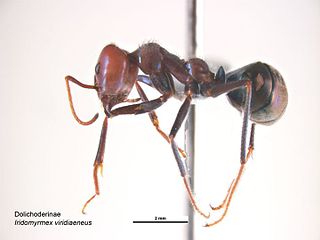
Dolichoderinae is a subfamily of ants, which includes species such as the Argentine ant, the erratic ant, the odorous house ant, and the cone ant. The subfamily presents a great diversity of species throughout the world, distributed in different biogeographic realms, from the Palearctic, Nearctic, Afrotropical region and Malaysia, to the Middle East, Australian, and Neotropical regions.

Iridomyrmex is a genus of ants called rainbow ants first described by Austrian entomologist Gustav Mayr in 1862. He placed the genus in the subfamily Dolichoderinae of the family Formicidae. It has 79 described species and five fossil species. Most of these ants are native to Australia; others are found in Asia and Oceania, and they have been introduced to Brazil, New Zealand, and the United Arab Emirates. Fossil species are known from China, France, and the United States.

Liometopum is a genus of ants that belongs to the subfamily Dolichoderinae, found in North America, Europe and Asia.

Philidris is a genus of ants in the subfamily Dolichoderinae. The genus is known from tropical forests from eastern India to northern Australia. It is similar to the genus Iridomyrmex, from where the type species was transferred from by Shattuck (1992).

Ochetellus is a genus of ants first described by Steve Shattuck in 1992. He placed it in the subfamily Dolichoderinae of the family Formicidae. The ants in this genus are small and black in colour; workers measure 1.75 to 3 millimetres in length, the males at around 1.6 millimetres (0.06 in) are smaller, and the queens are the largest, reaching 4 millimetres (0.16 in). There are seven described species and three described subspecies that mostly live in Australia in a wide variety of habitats, but some species are found in Asia. One species, Ochetellus glaber, has been introduced into New Zealand and the United States.
Iridomyrmex bicknelli is a species of ant belonging to the genus Iridomyrmex. The species is distributed in every single state and territory in Australia. Iridomyrmex bicknelli was described by Emery in 1898.
Iridomyrmex calvus is a species of ant belonging to the genus Iridomyrmex. Described in 1914, the species is native to Australia and New Caledonia.
Eldermyrmex is an extinct genus of ant in the Formicidae subfamily Dolichoderinae. The genus contains a single described species Eldermyrmex oblongiceps. Eldermyrmex is known to be from the Baltic Amber.

Yantaromyrmex is an extinct genus of ants first described in 2013. Members of this genus are in the subfamily Dolichoderinae of the family Formicidae, known from Middle Eocene to Early Oligocene fossils found in Europe. The genus currently contains five described species, Y. constrictus, Y. geinitzi, Y. intermedius, Y. mayrianum and Y. samlandicus. The first specimens were collected in 1868 and studied by Austrian entomologist Gustav Mayr, who originally placed the fossils in other ant genera until the fossils were reviewed and subsequently placed into their own genus. These ants are small, measuring from 4 to 6 mm in length and can be characterized by their trapezoidal shaped head-capsules and oval compound eyes that are located slightly to the rear of the capsules midpoint, with no known ocelli present.
Iridomyrmex azureus is a species of ant in the genus Iridomyrmex. Described by Viehmeyer in 1914, specimens collected have been found in dry habitats in Western Australia and South Australia, and also in New South Wales and the Northern Territory.
Iridomyrmex mattiroloi is a species of ant in the genus Iridomyrmex. Described by Carlo Emery in 1898, the species is only endemic to Tasmania in Australia, commonly seen foraging on low vegetation.
Iridomyrmex setoconus is a species of ant in the genus Iridomyrmex. Described by Shattuck and McMillan in 1998, the species is endemic to Australia, and small populations have only been found in Esperance.

Iridomyrmex viridiaeneus is a species of ant in the genus Iridomyrmex. Described by Viehmeyer in 1914, the species is among the most widespread species in Australia of the genus.
Ochetellus punctatissimus is a species of ant in the genus Ochetellus. Described by Emery in 1887, the ant is endemic to Australia.
Philidris laevigata is a species of ant in the genus Philidris. Described by Emery in 1895, the species is endemic to Burma, India and China.
Philidris myrmecodiae is a species of ant in the genus Philidris. Described by Emery in 1887, the species is endemic to Asia.
Anonychomyrma extensa is a species of ant in the genus Anonychomyrma. Described by Emery in 1887, the species may be endemic to Indonesia and New Guinea, as its exact location remains unknown.
Anonychomyrma fornicata is a species of ant in the genus Anonychomyrma. Described by Emery in 1914, the species is endemic to Australia.

Anonychomyrma murina is a species of ant in the genus Anonychomyrma. Described by Emery in 1911, the species is endemic to New Guinea.







